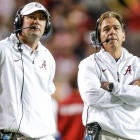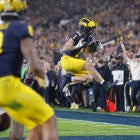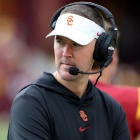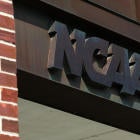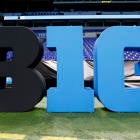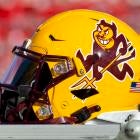The next time Nick Saban or Kirby Smart talk about how everything they do is in their players' best interest, remember Maurice Smith and A.J. Turman.
Smith is an Alabama defensive back who is being blocked from going to Georgia as a graduate transfer. Saban, citing SEC intra-conference transfer rules, said his policy is not to grant releases for players to go to other SEC schools "unless there was a special circumstance," the type Alabama said wide receiver Chris Black got in order to recently go from Alabama to Missouri.
Turman was a Georgia running back -- and not a graduate transfer like Smith -- who was restricted by Smart from transferring to Miami (where former Bulldogs coach Mark Richt landed), rival Georgia Tech or any SEC schools. Turman didn't want to go to Miami, but Smart said he put the restriction in to set a precedent.
Now Saban and Smart are squabbling over Smith, who has taken his story public. The whole thing is a mess.
Smith is even claiming someone at Alabama cleaned out his locker and put his personal belongings in the trash. Smart went so far as to say Saturday that he won't restrict Georgia graduate transfers from attending other SEC schools. That's a good blanket statement, unlike Saban's policy, but Smart tried to draw a distinction between blocking schools for grad transfers and undergrads.
I've had readers take both sides of the Saban vs. Smart debate and ask where I stand. Both coaches are missing the main point, even though they're both acting within NCAA and SEC rules. The solution should always be the simplest one: do what's best for the player. Take the high road when a player wants out in a system stacked against him.
That's what happened when Ole Miss granted a release this offseason to kicker Andy Pappanastos, who graduated in the spring and transferred to Alabama with immediate eligibility. Pappanastos was on scholarship at Ole Miss but rarely played. He is a walk-on at Alabama and figures to compete for Alabama's starting kicker job in 2017, though he could play sooner if needed, AL.com reported in March. Saban had no problem accepting Pappanastos from another SEC school, yet Smith's interest to transfer to Georgia is deemed unacceptable.
What's happening with the Saban and Smart debate is what too often occurs when a player transfers. Coaches and schools view players as assets they can control. Saban and Smart want what's best for the player -- unless what's best may not align with the competitive interests of the coach.
The NCAA can't have it both ways. You can't say these are students, and not employees, and that college sports is about education but then restrict where they transfer. This is about athletes' ability to accept a scholarship somewhere else, something any other student could do without this hassle.
Players can be valuable assets. So treat them that way and allow them to capitalize off their value. If you're going to restrict their movement, acknowledge doing so is a business decision and treat players like employees by negotiating non-compete provisions in contracts. If you're saying this business is about education, then let a player choose whatever university he or she wants once everyone accepts the player is leaving.
What we're talking about here is coaches want to maximize the most from players after training them, feeding them and paying for their education. You would, too, if your job depended on wins and losses instead of graduation rates.
But colleges and businesses train people all the time that move on to competitors. That's life.
Ask Saban, who once had four head-coaching jobs in nine years. Ask Smart, who once had six assistant coaching jobs in seven years. They had their choice of jobs, just as their departing players should have their choice of school.
And now for this week's college football mailbag questions ...
I am a Badgers fanatic. I know the schedule is tough, but not in the coaches poll top 25? Explain.
-- @DougGreenB
Consider this my annual reminder that preseason football polls don't mean a thing. Last season's preseason top 10 included two teams that finished unranked (Auburn and USC), one that fired its coach (Georgia) and one that blew a 31-point lead in a bowl to a backup quarterback (Oregon). But since polls are meant to be fun, let's explore Doug's question about Wisconsin.
The Badgers went 10-3 in 2015 and finished 21st in the final Coaches Poll. Their only losses were to national champion Alabama, near Big Ten champion Iowa and 10-win Northwestern. Also, Wisconsin won the Holiday Bowl over USC, which is No. 17 in the preseason poll because, well, it's USC and that's what happens with preseason polls.
I suspect many voters are worried about two things with Wisconsin. First, highly respected defensive coordinator Dave Aranda is now at LSU. That's a tough loss. Second, after avoiding Ohio State, Michigan State and Michigan the last two years, the Badgers face all three in 2016. Check out this six-game stretch from Sept. 24 to Nov. 5: at Michigan State, at Michigan, bye, Ohio State, at Iowa, Nebraska, at Northwestern. Phil Steele labels Wisconsin's schedule strength the biggest jump of any team in the country.
Does Deshaun Watson have a chance at 60 total touchdowns?
-- @bulletptsports
Whoa, 60 is a huge number for combined throwing and rushing touchdowns. But if Clemson's offense is as scary as many people think it will be in 2016, and if the Tigers need to win more shootouts given their departures on defense, maybe it's a number we need to track.
Watson totaled 47 touchdowns last year (35 passing, 12 rushing). The FBS record is 63 by Hawaii's Colt Brennan in 2006. To put 60 in perspective, Cam Newton "only" totaled 50 in 2010 during his once-in-a-generation Heisman Trophy season at Auburn. When Florida went all out for Tim Tebow to win the Heisman Trophy in 2007, he totaled 55 touchdowns. Most recently, Oregon's Marcus Mariota had 57 in 2014 as the Heisman winner.
Is Watson capable of sniffing 60? Yes. But as Newton, Tebow and Mariota showed, that's a hell of a high bar to reach.
If Notre Dame decides to move its football program into the ACC full time, is the best option to leave the conference at 15 teams? With three pods of five teams and a nine-game schedule, every team would play each other at least every two years. Then you take the two best records of the three division winners for the conference championship game.
North Division: Notre Dame, Louisville, Pittsburgh, Syracuse, Boston College. Mid-Coast Division: Virginia, Virginia Tech, North Carolina, Duke, Wake Forest. South Division: Miami, Florida State, Georgia Tech, Clemson, North Carolina State.
-- David B.
I can't begin to tell you how many questions I have received like this through the years. Nothing stirs the imagination of readers quite like expansion and realigning conference divisions.
David's hypothetical scenario with a three-pod conference is certainly intriguing. (The tiebreaker scenarios, though, could be maddening! And man, that would be a loaded South Division.) However, under current NCAA rules, the ACC can't do three pods and stage a championship game. The Big 12 and ACC had proposed fully deregulating championship games. The Big Ten didn't want it, largely out of concern of the ACC's unconventional ideas it discussed in the past.
The new NCAA rule allows any conference with fewer than 12 members to hold a championship game between the top two teams in the standings providing the league has a round-robin schedule. Otherwise, you currently need two divisions for a championship game. The ACC could always try to change the rule again in the future.
What's the REAL reason schools oppose players making outside income? Power balance shift? Loss of parity? Fans? Other?
-- @jeff_haugh
I can't think of any monopoly in world history that willingly has given up control. The NCAA has a great racket going by capping the work force (the players) at their scholarship value plus cost of attendance.
For some people who work in college sports, they truly believe players should not be allowed to get any money. It's a genuine belief based on principle and educational values, even though the NCAA definition of amateurism has constantly evolved. For others, I suspect the real fear is potentially losing some donor/sponsorship dollars that normally go to the schools but would trickle to players if they could get paid outside money. That's less money for administrators and coaches to get paid, and it does shift some of the power balance.
As it is now, Nick Saban earns $7.1 million and Kirby Smart makes $3.75 million in an industry we're told is about higher education. Yet they can restrict where their "student-athletes" transfer. Amateurism!
If you have a question for Jon Solomon's College Football Mailbag, contact him via email at solomonjt2003@yahoo.com or Twitter @JonSolomonCBS.












